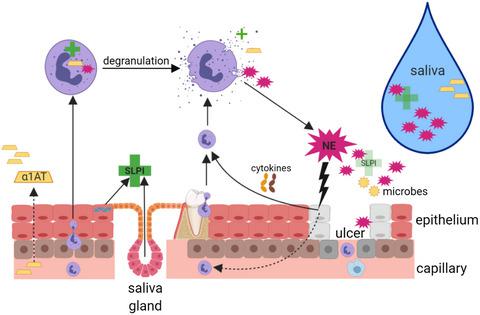当前位置:
X-MOL 学术
›
Clin. Exp. Immunol.
›
论文详情
Our official English website, www.x-mol.net, welcomes your
feedback! (Note: you will need to create a separate account there.)
Neutrophil elastase and endogenous inhibitors in Behçet's disease saliva.
Clinical & Experimental Immunology ( IF 3.4 ) Pub Date : 2020-06-24 , DOI: 10.1111/cei.13483 T Novak 1, 2 , F Fortune 1 , L Bergmeier 1 , I Khan 1, 3 , E Hagi-Pavli 1
Clinical & Experimental Immunology ( IF 3.4 ) Pub Date : 2020-06-24 , DOI: 10.1111/cei.13483 T Novak 1, 2 , F Fortune 1 , L Bergmeier 1 , I Khan 1, 3 , E Hagi-Pavli 1
Affiliation

|
Behçet’s disease (BD) is a vasculitis of unknown aetiology typified by chronic recurrent oral ulcers and systemic inflammatory manifestations. Neutrophils, and specifically their protease neutrophil elastase (NE), have been implicated in its pathology. Although NE is an effective anti‐microbial, excessive NE can damage host tissue. Recurrent oral ulceration is a primary BD symptom, therefore we hypothesized that excessive neutrophil infiltration evidenced by increased NE and a reduction in specific endogenous inhibitors, secretory leucocyte protease inhibitor (SLPI) and alpha1‐anti‐trypsin (α1AT) contributes to BD mucosal instability. NE, SLPI and α1AT were quantified in saliva from BD patients with active oral ulcers (BDa) and quiet without ulcers (BDq), recurrent aphthous stomatitis (RASa; RASq) and healthy controls (HC). Although BDq saliva had marginally higher median NE levels (1112 ng/ml) compared to both RASq (1043 ng/ml) and HC (999 ng/ml), SLPI was significantly reduced in BDq (P < 0·01). Despite decreased SLPI protein, mRNA expression was significantly increased in BDq buccal epithelial swabs compared to RASq and HC (P < 0·05, P < 0·001). NE remained enzymatically active, although α1AT levels were at least eight times higher than SLPI in all groups, suggesting that α1AT does not have a primary role in counteracting NE in saliva. Furthermore, NE levels in BDa patients medicated with both azathioprine (AZA) and colchicine (COLC) were significantly lower than those on COLC (P = 0·0008) or neither (P = 0·02), indicating that combining AZA + COLC may help to regulate excessive NE during ulceration. This study showed that enzymatically active NE coupled with reduced SLPI in BD saliva may contribute to recurrent oral ulcerations.
中文翻译:

白塞病唾液中的中性粒细胞弹性蛋白酶和内源性抑制剂。
白塞氏病(BD)是一种病因不明的血管炎,以慢性复发性口腔溃疡和全身炎症表现为代表。中性粒细胞,特别是其蛋白酶中性粒细胞弹性蛋白酶(NE),与其病理学有关。虽然 NE 是一种有效的抗菌剂,但过量的 NE 会损害宿主组织。复发性口腔溃疡是 BD 的主要症状,因此我们假设 NE 增加和特定内源性抑制剂、分泌性白细胞蛋白酶抑制剂 (SLPI) 和 α1 抗胰蛋白酶 (α1AT) 减少所证明的过度中性粒细胞浸润导致 BD 粘膜不稳定。对患有活动性口腔溃疡 (BDa) 和安静无溃疡 (BDq)、复发性口疮性口炎 (RASa; RASq) 和健康对照 (HC) 的 BD 患者唾液中的 NE、SLPI 和 α1AT 进行定量。尽管与 RASq (1043 ng/ml) 和 HC (999 ng/ml) 相比,BDq 唾液的中位 NE 水平 (1112 ng/ml) 略高,但 BDq 中的 SLPI 显着降低 ( P < 0·01)。尽管 SLPI 蛋白减少,但与 RASq 和 HC 相比,BDq 颊上皮拭子中 mRNA 表达显着增加( P < 0·05, P < 0·001)。尽管所有组中 α1AT 水平至少比 SLPI 高八倍,但 NE 仍然具有酶活性,这表明 α1AT 在抵消唾液中的 NE 方面并不起主要作用。此外,同时服用硫唑嘌呤 (AZA) 和秋水仙碱 (COLC) 的 BDa 患者的 NE 水平显着低于服用 COLC 的患者 ( P = 0·0008) 或两者都不服用 ( P = 0·02),这表明联合使用 AZA + COLC 可能会降低患者的 NE 水平。有助于调节溃疡期间过多的NE。 这项研究表明,BD 唾液中具有酶活性的 NE 与 SLPI 降低可能会导致复发性口腔溃疡。
更新日期:2020-06-24
中文翻译:

白塞病唾液中的中性粒细胞弹性蛋白酶和内源性抑制剂。
白塞氏病(BD)是一种病因不明的血管炎,以慢性复发性口腔溃疡和全身炎症表现为代表。中性粒细胞,特别是其蛋白酶中性粒细胞弹性蛋白酶(NE),与其病理学有关。虽然 NE 是一种有效的抗菌剂,但过量的 NE 会损害宿主组织。复发性口腔溃疡是 BD 的主要症状,因此我们假设 NE 增加和特定内源性抑制剂、分泌性白细胞蛋白酶抑制剂 (SLPI) 和 α1 抗胰蛋白酶 (α1AT) 减少所证明的过度中性粒细胞浸润导致 BD 粘膜不稳定。对患有活动性口腔溃疡 (BDa) 和安静无溃疡 (BDq)、复发性口疮性口炎 (RASa; RASq) 和健康对照 (HC) 的 BD 患者唾液中的 NE、SLPI 和 α1AT 进行定量。尽管与 RASq (1043 ng/ml) 和 HC (999 ng/ml) 相比,BDq 唾液的中位 NE 水平 (1112 ng/ml) 略高,但 BDq 中的 SLPI 显着降低 ( P < 0·01)。尽管 SLPI 蛋白减少,但与 RASq 和 HC 相比,BDq 颊上皮拭子中 mRNA 表达显着增加( P < 0·05, P < 0·001)。尽管所有组中 α1AT 水平至少比 SLPI 高八倍,但 NE 仍然具有酶活性,这表明 α1AT 在抵消唾液中的 NE 方面并不起主要作用。此外,同时服用硫唑嘌呤 (AZA) 和秋水仙碱 (COLC) 的 BDa 患者的 NE 水平显着低于服用 COLC 的患者 ( P = 0·0008) 或两者都不服用 ( P = 0·02),这表明联合使用 AZA + COLC 可能会降低患者的 NE 水平。有助于调节溃疡期间过多的NE。 这项研究表明,BD 唾液中具有酶活性的 NE 与 SLPI 降低可能会导致复发性口腔溃疡。











































 京公网安备 11010802027423号
京公网安备 11010802027423号